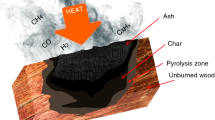Abstract
The fire retardancy behaviour of wood–polypropylene composites containing different fire retardants [melamine, zinc borate and ammonium polyphosphate (APP)] has been studied with the cone calorimetry technique. The effect of APP in combination with graphite has been also studied with a cone calorimeter test. The fire properties measured in the cone calorimeter are discussed, including the heat release rate (HRR), total heat release, effective heat of combustion, ignition time, specific extinction area, smoke production, and mass loss rate. The results of the study show that zinc borate reduces the HRR efficiently. On the basis of the study it is evident that melamine has very little influence on the flammability of a wood–polypropylene composite, but it reduces smoke formation. APP, used alone, has increased smoke production significantly, while the production of smoke as well as other fire properties have been significantly improved when both APP and graphite have been added to the composite.




Similar content being viewed by others
References
Li B, He J (2004) Investigation of mechanical property, flame retardancy and thermal degradation of LLDPE-wood–fibre composites. Polym Degrad Stab 83:241–243.
Stark NM, White RH, Mueller S, Osswald T (2010) Evaluation of various fire retardants for use in wood flour-polyethylene composites. Polym Degrad Stab 95:1–2.
Najafi SK, Hamidinia E, Tajvidi M (2006) Mechanical properties of composites from sawdust and recycled plastics. J Appl Polym Sci 100:3641.
Taylor A, Yadama V, Englund K, Harper D (2009) Wood plastic composites—a primer. Univ Tenn:4.
Malvar LJ, Tichy R, Pendleton DE (2001) Fire issues in engineered wood composites for naval waterfront facilities. In: 46th international SAMPE symposium and exhibition, Long Beach, pp 1–2.
Garcia M, Hidalgo J, Garmendia I, Garcia-Jaca J (2009) Wood–plastics composites with better fire retardancy and durability performance. Composites A 40:1772–1774.
Manikandan Nair KC, Thomas S, Groeninckx G (2001) Thermal and dynamic mechanical analysis of polystyrene composites reinforced with short sisal fibres. Compos Sci Technol 61:2519.
Le Bras M, Duquesne S, Fois M, Grisel M, Poutch F (2005) Intumescent polypropylene/flax blends: a preliminary study. Polym Degrad Stab 88:80.
Kozlowski R, Wladyka-Przybylak M (2008) Flammability and fire resistance of composites reinforced by natural fibers. Polym AdvTechnol 19:446–451.
Stark NM, Mueller SA, White RH, Osswald TA (2009) Effect of fire retardants on heat release rate of wood flour-polyethylene composites. In: 10th international conference on wood and biofiber plastic composites, pp 103–104.
Roth M, Schwarzinger C, Mueller U, Schmidt H (2007) Determination of reaction mechanisms and evaluation of flame retardants in wood-melamine resin-composites. J Anal Appl Pyrol 79:306–307.
Sain M, Park SH, Suhara F, Law S (2004) Flame retardant and mechanical properties of natural fibre–PP composites containing magnesium hydroxide. Polym Degrad Stab 83:363–364.
Anon (2007) EFRA, The European flame retardants association, flame retardants, frequently asked questions: 2, 22.
Suppakarn N, Jarukumjorn K (2009) Mechanical properties and flammability of sisal/PP composites: effect of flame retardant type and content. Composites B 40:614.
Shen KK, Kochesfahani S, Jouffret F (2008) Zinc borates as multifunctional polymer additives. Adv Polym Technol 19:474.
Haurie L, Fernandez AI, Velasco JI, Chimenos JM, Lopez Cuesta JM, Espiell F (2007) Thermal stability and flame retardancy of LDPE/EVA blends filled with synthetic hydromagnesite/aluminium hydroxide/montmorillonite and magnesium hydroxide/aluminium hydroxide/montmorillonite mixtures. Polym Degrad Stab 92:1082–1087.
Chen L, Wang YZ (2010) A review on flame retardant technology in China. Part I: development of flame retardants. Polym Adv Technol 21:2–7, 9, 11, 13.
Anon (1996) Additives for polymers, zinc borates as fire retardant alternatives. Elsevier, USA, p 3
Baysal E, Yalinkilic MK, Altinok M, Sonmez A, Peker H, Colak M (2007) Some physical, biological, mechanical, and fire properties of wood polymer composite (WPC) pretreated with boric acid and borax mixture. Constr Build Mater 21:1880.
Anon (1995) Additives for polymers, zinc borate in wood composites. Elsevier, USA, p 6.
Childs PE (2003) Phosphorus: from urine to fire, Part 5: phosphates in fire retardants. http://www.ul.ie/~childsp/CinA/Issue65/TOC38_Phosporous.htm. Accessed 21 Nov 2012.
Demir H, Arkıs E, Balkose D, Ulku S (2005) Synergistic effect of natural zeolites on flame retardant additives. Polym Degrad Stab 89:478–479, 482.
Schartel B, Braun U, Schwarz U, Reinemann S (2003) Fire retardancy of polypropylene/flax blends. Polymer 44:6242.
Li J, Li B, Zhang X, Su R (2001) The study of flame retardants on thermal degradation and charring process of manchurian ash lignin in the condensed phase. Polym Degrad Stab 72:493–498.
Matko S, Toldy A, Keszei S, Anna P, Bertalan G, Marosi G (2005) Flame retardancy of biodegradable polymers and biocomposites. Polym Degrad Stab 88:139.
Lu SY, Hamerton I (2002) Recent developments in the chemistry of halogen-free flame retardant polymers. Prog Polym Sci 27:1663–1665, 1686, 1688–1689, 1698.
Troitzsch J (2004) Plastics flammability handbook, Principles, regulations, testing and approval, 3rd edn. Munich, p 22, 83, 158–160, ISBN 1-56990-356-5.
Rakotomalala M, Wagner S, Doring M (2010) Recent developments in halogen free flame retardants for epoxy resins for electrical and electronic applications, Materials, ISSN 1996-1944, p 4308, 4310–4311.
Horrocks AR, Price D (2001) Fire retardant materials, ISBN 1 85573-419-2, p 118.
Kodolov VI (1980) Fire retardants for polymeric materials, UDK 14.841.41:66.097.7 M. Chimia, p 107.
Carpenter K, Janssens M (2005) Using heat release rate to assess combustibility of building products in the cone calorimeter. Fire Technol 41:82.
Author information
Authors and Affiliations
Corresponding author
Rights and permissions
About this article
Cite this article
Nikolaeva, M., Kärki, T. Reaction-to-Fire Properties of Wood–Polypropylene Composites Containing Different Fire Retardants. Fire Technol 51, 53–65 (2015). https://doi.org/10.1007/s10694-013-0377-y
Received:
Accepted:
Published:
Issue Date:
DOI: https://doi.org/10.1007/s10694-013-0377-y




